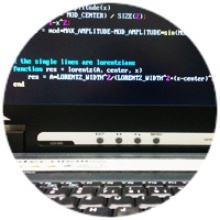Overview
The theory and simulation activities of the 4th Physics Institute are coordinated by the junior research group Physical Optics in close collaboration with the experimental work at the institute. The mutual exchange between theory and experiment on each step of the analysis enables us to directly verify theoretical models and their predictions. Our theoretical research activities include topics such as chiral and non-reciprocal plasmonics, hybrid quantum and nanophotonic systems, photonic crystal fibers and nonlinear optics, with a strong emphasis on development of semi-analytical models and advanced numerical methods.
Theory
The optical properties of micro- and nanostructures can be significantly modified by changing their shape and their spatial configuration. We can therefore design artificial systems with specific optical properties when understanding the underlying physical phenomena. This requires either semi-analytical or numerical solutions of Maxwell’s equations for various types of linear and nonlinear material responses. Especially metallo-dielectric systems turn out to be of great importance due to the occurrence of plasmonic resonances, i.e., collective oscillations of electrons in the metal. Potential applications are optical sensors, thin-film optical elements such as Faraday isolators and perfect absorbers, as well as integrated photonic circuits.
Methodology
Our theoretical work relies on commercial software such as finite difference time domain software and finite element methods, as well as semi-analytical approaches and own numerical codes. Regarding the latter, we have implemented an advanced scattering matrix approach for periodic nanostructures based on the Fourier modal method with adaptive coordinates. Our implementation significantly improves the convergence of the method, so that we are able to calculate the linear and nonlinear optical response of metallo-dielectric systems as well as chiral and non-reciprocal materials efficiently. Our code provides accurate results for far-field spectra, emitter calculations, near-field distributions, optical resonances, and density of states calculations. Furthermore, it is permanently improved by state of the art extensions in order to cope with the research activities at the 4th Physics Institute. Another in-house approach is the resonant state expansion, where the resonant states of a given system can be used in order to describe its optical response and how this response changes under small and large modifications of the system. This is particularly useful for the optimization of sensors, the modeling of the influence of disorder, and the description of non-reciprocal and hybrid quantum and nanophotonic systems.
- Analytic mode normalization for the Kerr nonlinearity parameter: Prediction of nonlinear gain for leaky modes
I. Allayarov, S. Upendar, M. Schmidt and T. Weiss
Phys. Rev. Lett. 121, 213905 (2018). - Analytical mode normalization and resonant state expansion for bound and leaky modes in optical fibers - an efficient tool to model transverse disorder
S. Upendar, I. Allayarov, M. Schmidt and T. Weiss
Opt. Express 26, 22536 (2018). - Gold nanocrystal-mediated sliding of doublet DNA origami filaments
M. Urban, S. Both, C. Zhou, A. Kuzyk, K. Lindfors, T. Weiss and N. Liu
Nat. Commun. 9, 1454 (2018). - Modeling of second-harmonic generation in periodic nanostructures by the Fourier modal method with matched coordinates
J. Defrance, M. Schäferling and T. Weiss
Opt. Express 26, 13746 (2018). - How to calculate the pole expansion of the optical scattering matrix from the resonant states
T. Weiss and E. Muljarov
Phys. Rev. B 98, 085433 (2018). - Resonant-state expansion for open optical systems: Generalization to magnetic, chiral, and bi-anisotropic materials
E. Muljarov and T. Weiss
Opt. Lett. 43, 1978 (2018). - Line-current model for linear and nonlinear optical properties of thin elongated metallic rod antennas
M. Nesterov, M. Schäferling, K. Weber, F. Neubrech, H. Giessen and T. Weiss
J. Opt. Soc. Am. B 35, 1482 (2018). - Highly Sensitive Refractive Index Sensors with Plasmonic Nanoantennas - Utilization of Optimal Spectral Detuning of Fano Resonances
M. Mesch, T. Weiss, M. Schäferling, M. Hentschel, R. Hedge and H. Giessen
ACS Sensors 3, 960 (2018). - Analytical Normalization of Resonant States in Photonic Crystal Slabs and Periodic Arrays of Nanoantennas at Oblique Incidence
T. Weiss, M. Schäferling, H. Giessen, N. Gippius, S. Tikhodeev, W. Langbein and E. Muljarov
Phys. Rev. B 96, 045129 (2017). - Lorentz Nonreciprocal Model for Hybrid Magnetoplasmonics
D. Floess, T. Weiss, S. Tikhodeev and H. Giessen
Phys. Rev. Lett. 117, 063901 (2016). - The role of plasmon-generated near-fields for enhanced circular dichroism spectroscopy
M. Nesterov, X. Yin, M. Schäferling, H. Giessen and T. Weiss
ACS Photonics 3, 578 (2016). - Reducing the complexity: Enantioselective chiral near-fields by diagonal slit and mirror configuration
M. Schäferling, N. Engheta, H. Giessen and T. Weiss
ACS Photonics 3, 1076 (2016). - From Dark to Bright: First-Order Perturbation Theory with Analytical Mode Normalization for Plasmonic Nanoantenna Arrays Applied to Refractive Index Sensing
T. Weiss, M. Mesch, M. Schäferling, H. Giessen, W. Langbein and E. Muljarov
Phys. Rev. Lett. 116, 237401 (2016). - Matched coordinates and adaptive spatial resolution in the Fourier modal method
T. Weiss, G. Granet, N. Gippius, S. Tikhodeev and H. Giessen
Optics Express 17, 8051 (2009).



